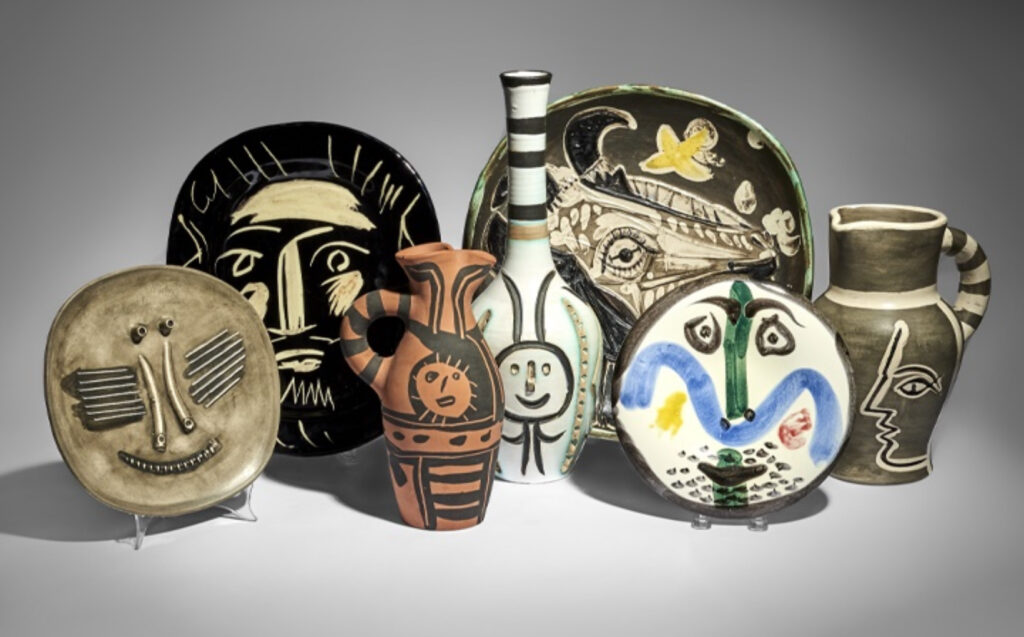
When one thinks of Pablo Picasso, the mind wanders through fractured visages, explosive forms, and brushstrokes shaped by war, love, and relentless reinvention. Yet beyond the sprawling canvases and Cubist declarations, there lies a quieter medium—earthbound, tangible, and intimate: ceramics. In May 2025, Geneva became the unexpected stage for one of the most tender chapters in the Picasso oeuvre, as a collection of never-before-seen ceramic works, gifted by the artist’s heirs to a family friend in the 1980s, emerged from decades of obscurity to meet the open air of the auction block.
The sale, held by Geneva’s venerable Piguet Auction House, was not just an event—it was an excavation of memory. These ceramic pieces, previously undocumented and entirely absent from public exhibitions, were fired not only in kilns, but in familial warmth, friendship, and personal trust. Unlike many of Picasso’s posthumously commercialized objects, these bowls, pitchers, and platters were created not for the market, but for those who knew him. Now, they arrive with the faint scent of kitchen tables and whispered confidences—a collection glazed in affection and untouched by curatorial hands.
Rediscovery in Clay
Picasso began working with ceramics in earnest in the late 1940s, after being introduced to the Madoura pottery studio in Vallauris, France. There, he reimagined the humble pot as a surface for reinvention, breathing myth, play, and painterly rhythm into terra cotta. Bulls, doves, fauns, and faces danced across pitchers and vases; the everyday became enchanted.
But while hundreds of his Madoura editions were catalogued and distributed—often stamped and numbered—the Geneva collection defies that narrative. These are unique, unduplicated pieces, given directly from the hands of his children, Claude and Paloma Picasso, to a close family friend who lived part-time in the Swiss countryside. Preserved with deliberate discretion, the ceramics sat in the quiet shadow of fame, nested in linen and passed down privately through a generation, until the current heir chose this moment to share their glow.
The Collection: Aesthetic and Intimate
The ceramics in question are modest in number—21 individual works, each with distinct motifs, ranging from abstracted animal forms to classic Iberian masks and sunlit Provençal scenery. There is a sense of spontaneity in the brushwork—quick swipes of cobalt, umber, and saffron—preserved in the fired glaze, like handwriting on hardened parchment. These are not monumental declarations. They are sketches in clay. Sentiments made permanent.
One standout piece is a round earthenware platter depicting a minotaur, rendered not with violence, but a curious, almost vulnerable grace. His eye, wide and almond-shaped, suggests longing more than menace. In another, a pitcher becomes a bird mid-flight—the spout a beak, the handle an elongated wing. What’s remarkable here is not the scale or technical feat, but the playful intimacy—works that feel like afterthoughts of a genius, which in Picasso’s case, still carry seismic weight.
There are no forgeries here, no mass-released editions. Each object comes with detailed provenance documentation, including photographs from the 1980s of Claude Picasso handing over the items during a family holiday near Montreux. These images alone became auction fodder, appearing in catalogs and press releases like relics of another, slower world.
The Auction: Reverence Over Frenzy
Unlike the breathless buzz surrounding blue-chip modern art sales in New York or Hong Kong, Geneva’s tone was more reflective, even reverent. The room—composed of seasoned collectors, museum representatives, and quietly curious gallerists—fell into a hushed rhythm as each lot was revealed. There were no fireworks. No gavel theatrics. Only the soft click of paddles and the clink of wine glasses between bids.
The final tally stunned even the auctioneers: CHF 5.4 million across the collection, with the minotaur platter alone fetching CHF 850,000, far beyond its estimated CHF 250,000. Rumors swirl that a prominent Spanish institution may have claimed it, aiming to reintroduce the work to its ancestral cultural context. Others will likely disappear back into private hands, perhaps to sleep once again beneath linen.
Ceramics as Testament
What elevates this auction beyond its price tags is the notion that Picasso’s ceramics were never secondary. Though often dismissed as hobbyist in tone or categorized as decorative rather than fine art, these works possess their own gravity. Picasso himself saw them not as departures, but as extensions—clay as canvas, fire as brush.
The Geneva collection makes that case convincingly. These were not mass-produced. They were not made to be shown. They are emotional, experimental, and unconcerned with market. If painting was Picasso’s public declaration, ceramics were his secret letter. Each bowl an anecdote. Each pitcher a joke told late at night. Every drip of glaze a loose thread in the broader fabric of 20th-century art history.
The Family Thread
What gives the auction its rare tenderness is the story of friendship behind the sale. The recipient of the collection, a French-Swiss woman named Sylvie B., worked as a landscape gardener near Antibes, where she became acquainted with the Picasso children through local horticultural projects in the 1970s. According to her letters—some of which were read aloud at the auction preview—Claude and Paloma entrusted the works to her “as one gives something to a sister, or a gentle keeper.”
That trust was never broken. Sylvie stored the works carefully, never insuring them, never displaying them publicly, and only now—decades later, in her seventies—choosing to bring them into the world. In interviews, she stated, “They were never mine to own, only mine to protect.”
After the Kiln
As the final lots closed and attendees trickled into Geneva’s twilight, the moment left behind a cooling trail of contemplation. Not just of Picasso’s restless genius, but of what it means to make something with one’s hands—something meant not for spectacle, but for safekeeping.
In an art world dominated by spectacle, blockbuster retrospectives, and investment portfolios, the 2025 Geneva ceramic auction offered something softer. It reminded us that the smallest vessel can hold the deepest memory, and that even the world’s most famous artist needed earth, fire, and intimacy to fully express the texture of being alive.
No comments yet.








